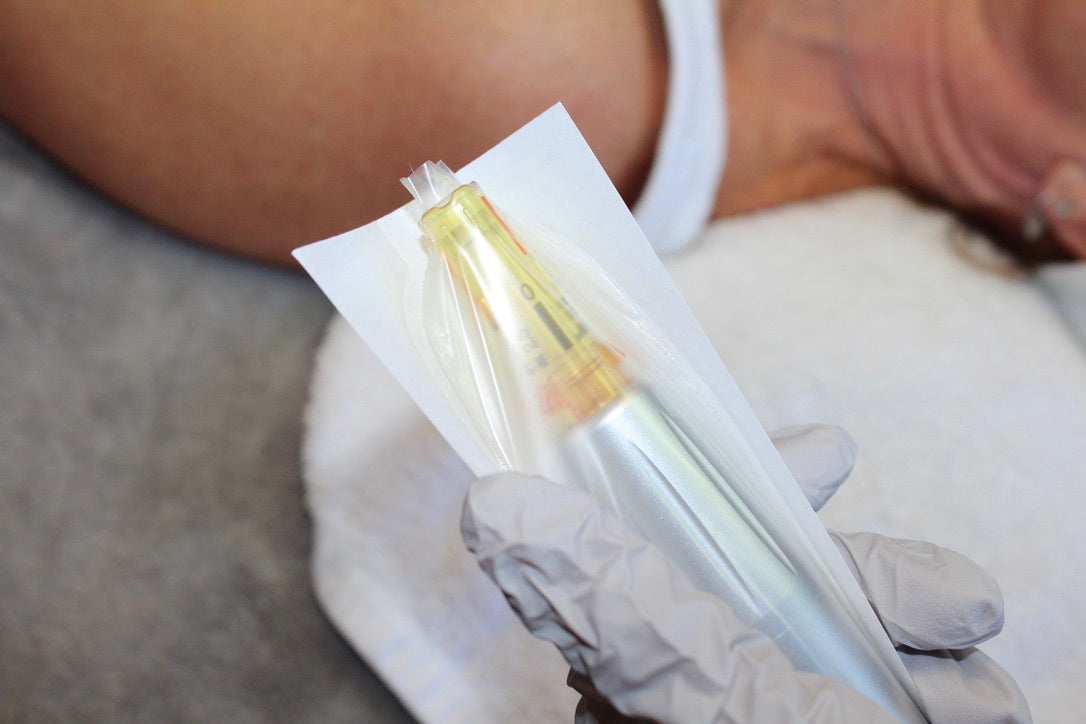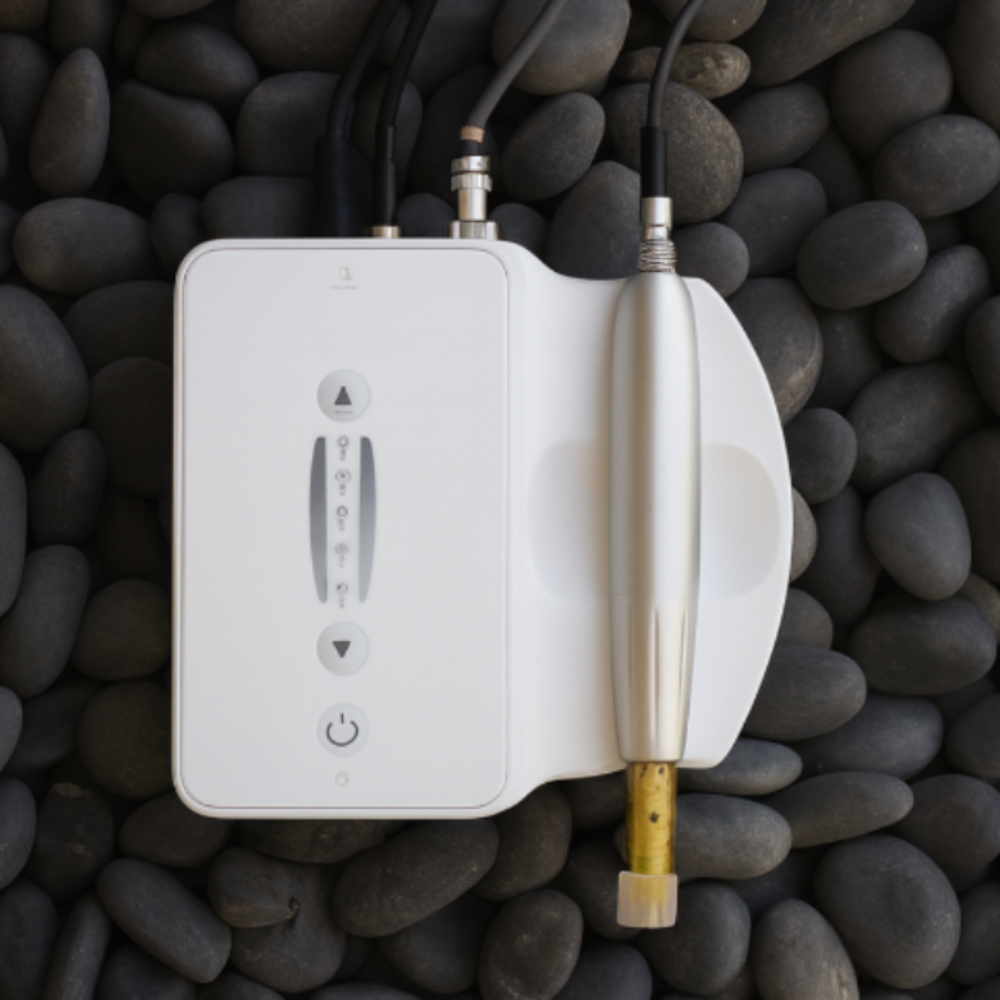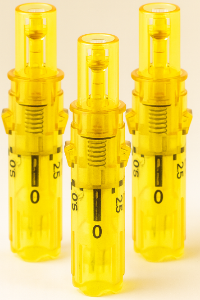Dermapen PRP - Microneedling PRP with Dr Mozersky
Casey IsomDermapen PRP
Dr. Mozersky discovered Dermapen prp at a conference in early 2011, and when he saw it he immediately thought it could be used to deliver platelet-rich plasma (PRP), which he had trouble delivering to his patients in a tolerable manner despite promising outcomes. He does not claim to have invented the technique, which he basically describes as follows: Chemically-activated PRP is painted onto the skin. Dermapen creates patterns of controlled injury that heal quickly but drive the PRP into the skin to promote improved penetration of the various growth factors and other beneficial components. He recommends it for most patients; in his experience it seems to decrease the number of treatments needed and also improves the overall result (as well as patient satisfaction). He supposes one could skip PRP activation or paint Dermapen prp on after creating the wound zones but has not studied any of these techniques in a structured clinical trial.
One notable issue with Dr. Mozersky's technique is that one's face looks all bloody and somewhat horrifying after the Dermapen prp is painted on. To mitigate this they do PRP parties, which he says are becoming popular; 7 or 8 women come together and receive treatment. This turns a potentially strange experience into a fun party with snacks and social time.
Additionally Dr. Mozersky uses Dermapen prp for stretch marks and surgical scars. He described one case where a patient with extensive striae had responded very well to therapy; the condition didn't completely resolve but the outcome was highly pleasing to the patient.
Overall he is impressed by Dermapen's prp simplicity, ease of use, safety and efficacy, especially in relation to its cost. High piston speed with slow passes can cause more superficial damage (some crustiness as a side effect), and vice versa for less damage, with increased utility due to the adjustable depth, especially in delicate areas (such as periocular region). For PRP he prefers lower piston speed with depth dependent on the area being treated. This treatment is suggested by Dr.Mozersky and is not and approved Indication of use by the FDA. Dermapen LLC cannot suggest treatments in the United States. We reprint white papers as requested by our Practitioners
"I have been using Dermapen prp for the treatment of patients with wrinkles, acne scars, and hypertrophic surgical scars. I have used it both alone, and in combination with platelet rich plasma (PRP). This technology when used alone provides an effective and cost effective method for stimulating collagen production and fibroblast proliferation. When combined with PRP these effects are potentiated. My patients are very comfortable, and the early results make them eager to complete their course of treatment."
David Mozersky, M.D., Interview about Dermapen PRP Treatment
How long have you been using Dermapen prp treatments in your office?
Over a year. Here's what happened: I was at the American Academy of Plastic Surgery in Las Vegas and I was walking down the row and I saw this DermaPen display. Sometimes a little light goes on in your head. In this case, I had for a long time been interested in using PRP to rejuvenate aging skin. Up until then I had been injecting it into the skin with needles. It worked very well but the needle approach was very poorly tolerated by my patients. Although I liked the results, it was hard to encourage them to do this multiple times which was necessary for a long-term result. When I saw the DermaPen, I thought that's it! That's how we're going to give them the PRP! Basically, my primary interest was a way of inoculating the PRP into the skin. So, I suggested that to the DermaPen people who were there.They never even thought about that, so I suggested it and of course I started doing it and we got a little experience with the technique.
So you basically then invented this technique and have successfully employed it. Describe then, how the technique is performed.
I don't know if I invented it, but I've used it that way and I told them what I was doing. I don't claim to have invented it, however.
Can you describe why that technique works in terms of delivering PRP with the DermaPen and why it's effective? What is it about the DermaPen and the PRP that makes it work together so synergistically?
PRP is platelet rich plasma made from spinning blood down and removing the red cells and the plasma layer that doesn't contain a lot of platelets and leaving the buffy coat and the layer of plasma that does contain a lot of platelets so you can increase the platelet content of serum by 1,400 times by doing this through centrifuging. The significance of that is that the platelets are the elements of the blood that initiate the healing process and if you cut yourself,the body responds by rushing platelets to the area which get deposited in wounds and activate themselves biologically to liberate material that initiates the healing process. These are called growth factors. They can stimulate new blood vessel formation, collagen and cell growth.
The problem with skin rejuvenation is that as we get older our bodies don't regenerate all these materials as rapidly as they did when we were young. Skin is in evolution. Just because you're 43 your skin is much younger. All the cells keep forming new ones, maturing, moving to the surface and dying and replenishing by new cells. But that process slows down. If it slows down, the skin isn't healthy, it doesn't have the youth it once had, resulting in wrinkles, crepiness, fragility, etc. In order to rejuvenate the skin, one method is to trick it into thinking it's been injured so the body responds by healing it, which is mediated through these platelets.
Laser, fractional laser and fractional ultrasonic treatments are always doing controlled injuring to the deeper part without damaging the dermal layer. The body responds to this injury by rushing platelets to the area and reforming the collagen and getting it to proliferate.
So what the DermaPen does is causes tiny injuries with it's micro-needles in a very controlled way. What we've done is taken this PRP, activated the platelets chemically and painted it on the skin before the DermaPen treatment. So when we make the hole in the skin, it's driving some of these healing growth factors in through the hole and into the deeper layers of the dermis so you can really magnify the effect of the DermaPen by coupling it with PRP.
So is the activation with the platelets with the chemical a recommended procedure with PRP for therapy or is it something you came up with?
I think in this situation you want to make sure the platelets release their growth factors and they don't do that unless they're activated, so we're trying to put them into a very superficial layer of skin and make sure those things get activated. You can probably do it without activating the platelets, but I prefer to activate them.
What other indications do you use the DermaPen for and what kind of results have you been seeing?
We use the DermaPen for treatment of abdominal stretch marks and surgical scars and have had very good success with that. We have a patient with extensive stretch marks who has responded very nicely to DermaPen. It hasn't cured it, but definitely helped to the point where she is much happier than she was. Then we had lots of people with scars from breast surgery and other kinds of surgery that have been aided considerably with DermaPen.
How would you compare it then to other modalities you used for scar revision and what is the advantage of using DermaPen overall?
I think it's definitely easy to use. It's extremely well tolerated by the patients. The cost factor is minimal compared to buying an expensive laser. From an effectiveness point of view, you think about how this pen tip can go up to 90 Hz and that's with 11 needles. That's 990 holes in the skin in a second. That is substantial damage you can do, which is extremely favorable when compared to other modalities. I love it because it's simple and inexpensive. It's effective and I think of it like a pencil eraser. How simple-minded can you get, but how effective can you be? You kind of have to see it to believe it.
What speeds do you use? Do you tailor the treatments?
We try and tailor the speed of the piston, the speed of moving the pen and depth of piston to the area that we're treating and the goal. We want to do a lot of superficial damage for some reason, someone has a lot of pigmentation or something, we might use a very high speed at a very slow rate and make a lot of small holes and kink a little crustiness after as a side effect, but just using to inoculate PRP we use a fairly low speed and we vary the depth depending on the area of the face being treated. The cheek, for example, we may use a 2mm tip and if it's around the eye skin we might go down to 0.5. we try to vary that based on the nature of the problem we're treating.
When you talk about the different indications you've used DermaPen with, am I to assume you're also using PRP as well?
Not necessarily. In some areas we use it by itself.
What makes you decide you will use Dermapen PRP with the treatment or not?
If we're treating wrinkles or crepiness of the skin, or trying to make the skin glow, we'll always recommend PRP. We have patients who don't want to do PRP and have basically just done the plain DermaPen and they get good results too. But I think the ones who get PRP, first of all I think it decreases the number of treatments they have to had and secondly, I think their satisfaction level is a little bit better.
What is it that makes some patients not want to go with Dermapen PRP? Is it a cost thing or they don't want blood drawn?
Both of those things. some people don't want to spend the extra money it takes to get the PRP, some people don't want to get stuck in the arm and have blood drawn. The other thing is it's more time consuming when they do it because we let them sit around the office for about an hour and a half before we wash their face and get rid of the blood that's on there. Otherwise they look like a lion who has just eaten a zepa. It's a very bad advertisement for our clinic.
So the painted concentrated plasma looks bloody and stays on their face.
Right. It's become so popular and people tell their friends, we've had PRP parties where maybe 7 or 8 ladies have come in at the same time, some will get photographs, some will be getting a treatment, some will be sitting around and by the end of the day they're all sitting around with blood all over their face eating some snacks and chatting. That is a popular format.
So you've made a thing out of it where they can all get it done together and it becomes fun and not so horrifying looking.
Right. A sisterhood forged in blood.
This treatment is suggested by Dr.Mozersky and is not and approved Indication of use by the FDA. Dermapen LLC cannot suggest treatments in the United States. We reprint white papers as requested by our practitioners.
| Dermapen® Microneedling Devices are exclusively sold to Medical and Skin Care Professionals. Use the form to the right to get started finding a Certified Dermapen® practitioner in your area. |
| Medical Clinics and Spas can offer their patients the worlds most advanced microneedling treatments with Dermapen |
| The Dermapen Microneedling Pen provides an unparalleled response through the segmented delivery of microneedles, creating micro injuries to the epidermis (outer layer of skin) and dermis (the inner layer of skin). As a result, the micro injuries encourage the body’s innate ability to repair itself. | Every Dermapen tip is outfitted with 12 needles and features our patented technologies, which include SureSpace™ and SafLok™. Accordingly, these safety enhancements can be found in every Dermapen needle tip and pen. | Furthermore, by using SureSpace™ and SafLok™ microneedling pen technologies, practitioners can deliver their patients the safest microneedling treatment possible, while getting the best microneedling results for their patients. |




